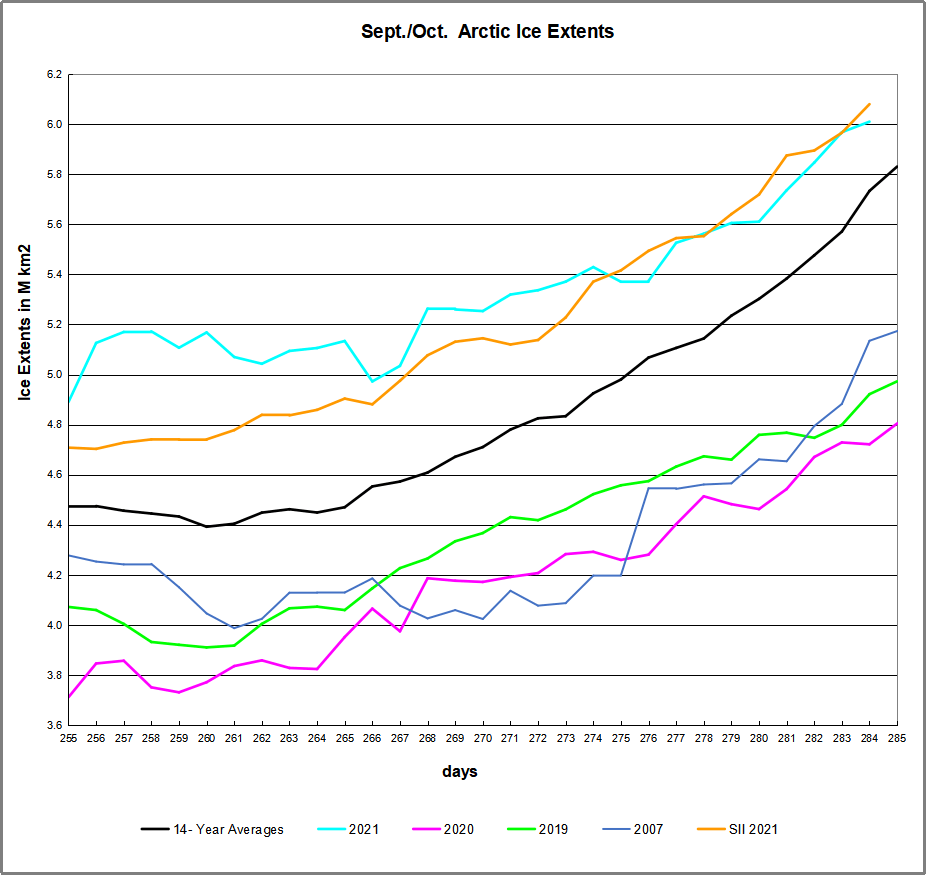The images above come from MASIE showing ice extents starting day 266, the lowest daily extent in 2021. Over the last 18 days, Arctic ice has grown by 1 Wadham (1M km2) to now exceed 6 Wadhams, about 276k km2 greater than the 14-year average for day 284. At the bottom center Barents Sea ice reaches out to Iceland. Svalbard bottom right becomes encircled by ice. East Siberian Sea top right has ice connecting to the shore. Top center Beaufort and Chukchi seas are also adding ice rapidly.
The ice recovery since September minimum is shown in the graph below. 
Day 260 was the 14 year average annual daily minimum at 4.39m km2. MASIE 2021 was 776k km2 above average, and SII was 427k km2 lower than MASIE. Note that 2007, 2019 and 2020 weere much lower than average throughout the period. SII is again tracking MASIE since day 274.
| Region | 2021284 | Day 284 Average | 2021-Ave. | 2007284 | 2021-2007 |
| (0) Northern_Hemisphere | 6010191 | 5733557 | 276634 | 5134886 | 875305 |
| (1) Beaufort_Sea | 787643 | 662884 | 124759 | 718210 | 69433 |
| (2) Chukchi_Sea | 547815 | 242829 | 304986 | 60352 | 487463 |
| (3) East_Siberian_Sea | 571575 | 434918 | 136657 | 311 | 571265 |
| (4) Laptev_Sea | 164089 | 298559 | -134470 | 409211 | -245122 |
| (5) Kara_Sea | 110917 | 80208 | 30710 | 128294 | -17377 |
| (6) Barents_Sea | 18 | 26816 | -26797 | 14013 | -13995 |
| (7) Greenland_Sea | 221491 | 318518 | -97027 | 423939 | -202449 |
| (8) Baffin_Bay_Gulf_of_St._Lawrence | 53199 | 77124 | -23925 | 84058 | -30859 |
| (9) Canadian_Archipelago | 474565 | 531008 | -56443 | 444876 | 29689 |
| (10) Hudson_Bay | 119 | 9213 | -9093 | 1936 | -1817 |
| (11) Central_Arctic | 3077617 | 3050338 | 27279 | 2848411 | 229206 |
The main deficits to average are in Laptev and Greenland Seas, and CA, offset by surpluses elsewhere, especially in BCE (Beaufort, Chukchi, East Siberian seas).
The Bigger Picture
We have passed the annual Arctic ice extent minimum, which typically occurs on or about day 260 (mid September). Some take any year’s slightly lower minimum as proof that Arctic ice is dying, but the image above shows the Arctic heart is beating clear and strong.
Over this decade, the Arctic ice minimum has not declined, but since 2007 looks like fluctuations around a plateau. By mid-September, all the peripheral seas have turned to water, and the residual ice shows up in a few places. The table below indicates where ice is found in September. Numbers are area units of Mkm2 (millions of square kilometers).
| Day 260 | 14 year | ||||||||||
| Arctic Regions | 2007 | 2010 | 2012 | 2014 | 2015 | 2017 | 2018 | 2019 | 2020 | 2021 | Average |
| Central Arctic Sea | 2.67 | 3.16 | 2.64 | 2.98 | 2.93 | 3.07 | 2.91 | 2.97 | 2.50 | 2.95 | 2.90 |
| BCE | 0.50 | 1.08 | 0.31 | 1.38 | 0.89 | 0.84 | 1.16 | 0.46 | 0.65 | 1.55 | 0.89 |
| LKB | 0.29 | 0.24 | 0.02 | 0.19 | 0.05 | 0.26 | 0.02 | 0.11 | 0.01 | 0.13 | 0.16 |
| Greenland & CAA | 0.56 | 0.41 | 0.41 | 0.55 | 0.46 | 0.52 | 0.41 | 0.36 | 0.59 | 0.50 | 0.46 |
| B&H Bays | 0.03 | 0.03 | 0.02 | 0.02 | 0.10 | 0.07 | 0.05 | 0.01 | 0.02 | 0.04 | 0.04 |
| NH Total | 4.05 | 4.91 | 3.40 | 5.13 | 4.44 | 4.76 | 4.56 | 3.91 | 3.77 | 5.17 | 4.48 |
The table includes some early years of note along with the last 5 years compared to the 14 year average for five contiguous arctic regions. BCE (Beaufort, Chukchi and East Siberian) on the Asian side are quite variable as the largest source of ice other than the Central Arctic itself. Greenland Sea and CAA (Canadian Arctic Archipelago) together hold almost 0.5M km2 of ice at annual minimum, fairly consistently. LKB are the European seas of Laptev, Kara and Barents, a smaller source of ice, but a difference maker some years, as Laptev was in 2016. Baffin and Hudson Bays are inconsequential as of day 260.
2021 stands out from lower ice years by the higher extents in Central Arctic, BCE and LKB, especially Kara Sea this year.

Resources: Climate Compilation II Arctic Sea Ice


Please would you let Greta know?
LikeLike
Greta only sees what Greta wants to see.
LikeLike
Reblogged this on Tallbloke's Talkshop and commented:
Attention COP26 attendees! Please refrain from flogging the dead horse of terminal Arctic sea ice decline.
LikeLike
Reblogged this on Climate Collections.
LikeLike
Minimum was quite early this year also.
LikeLike